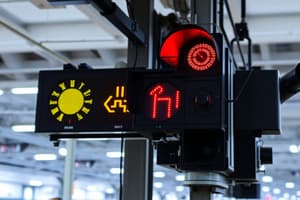Podcast
Questions and Answers
According to the provided content, what is the minimum safety level requirement for the Primary Train Detection system realized with software, ATP system, and Interlocking?
According to the provided content, what is the minimum safety level requirement for the Primary Train Detection system realized with software, ATP system, and Interlocking?
- SIL2
- SIL4 (correct)
- SIL1
- SIL3
Which of these aspects are explicitly addressed in the document's section dedicated to Cyber Security?
Which of these aspects are explicitly addressed in the document's section dedicated to Cyber Security?
- Implementation of a robust Intrusion Detection System (IDS)
- Establishing a comprehensive vulnerability assessment program
- Specifying the specific encryption algorithms to be used
- Ensuring data integrity during wireless data transmission (correct)
What is the maximum permissible probability of Wrong Side Failure for the complete Signalling and Train Control System per Train operating hour?
What is the maximum permissible probability of Wrong Side Failure for the complete Signalling and Train Control System per Train operating hour?
- 10-8
- 10-10
- 10-7
- 10-9 (correct)
What is the minimum calibration/inspection interval for the Signalling and Train Control System to achieve the specified safety performance requirements?
What is the minimum calibration/inspection interval for the Signalling and Train Control System to achieve the specified safety performance requirements?
What safety standard is referenced in the document for demonstrating the safety level of the Signalling and Train Control System?
What safety standard is referenced in the document for demonstrating the safety level of the Signalling and Train Control System?
What is stated to be the safety level for the Secondary Train Detection system realized through the Multi-Section Digital Axle counter?
What is stated to be the safety level for the Secondary Train Detection system realized through the Multi-Section Digital Axle counter?
What is implied by the statement "The Signalling and Train Control System shall not lead to an unsafe condition when the plug-in module / card / equipment is taken out"?
What is implied by the statement "The Signalling and Train Control System shall not lead to an unsafe condition when the plug-in module / card / equipment is taken out"?
Which of these is NOT explicitly mentioned as part of the information security framework and plan for the S&TC system?
Which of these is NOT explicitly mentioned as part of the information security framework and plan for the S&TC system?
Who is responsible for demonstrating the safety of the Signalling and Train Control System?
Who is responsible for demonstrating the safety of the Signalling and Train Control System?
What is the primary purpose of the GS (General Specification) document referenced in the document?
What is the primary purpose of the GS (General Specification) document referenced in the document?
Which of the following statements about the Bhopal and Indore Metro line project is NOT true?
Which of the following statements about the Bhopal and Indore Metro line project is NOT true?
According to the document, what is the primary purpose of the Design Specifications?
According to the document, what is the primary purpose of the Design Specifications?
What is the significance of the document's reference to APPENDIX A13 - Indigenisation - MoHUA Letter No. K-14011/1/2018-UT II Dt 27-7-2018 or latest?
What is the significance of the document's reference to APPENDIX A13 - Indigenisation - MoHUA Letter No. K-14011/1/2018-UT II Dt 27-7-2018 or latest?
Which of the following aspects of the project are NOT addressed in the document?
Which of the following aspects of the project are NOT addressed in the document?
What can be inferred from the text regarding the final stage of operation for the Bhopal and Indore Metro Systems?
What can be inferred from the text regarding the final stage of operation for the Bhopal and Indore Metro Systems?
Based on the information provided, what is the intended relationship between this document and "Vol III and its Appendices"?
Based on the information provided, what is the intended relationship between this document and "Vol III and its Appendices"?
What is the significance of the document's reference to "headway of 90 seconds"?
What is the significance of the document's reference to "headway of 90 seconds"?
Which standards must the wayside ATP equipment conform to for EMI requirements?
Which standards must the wayside ATP equipment conform to for EMI requirements?
What is required from the Contractor regarding the EMC control plan?
What is required from the Contractor regarding the EMC control plan?
For which of the following equipment must the onboard ATP conform to CENELEC standards?
For which of the following equipment must the onboard ATP conform to CENELEC standards?
Which aspect must the EMC control plan specifically analyze?
Which aspect must the EMC control plan specifically analyze?
What type of emissions should the EMC control plan aim to reduce?
What type of emissions should the EMC control plan aim to reduce?
What is required from the Contractor in terms of contract compliance?
What is required from the Contractor in terms of contract compliance?
Which version of IBM Rational DOORS must the tools be compatible with for monthly submissions?
Which version of IBM Rational DOORS must the tools be compatible with for monthly submissions?
What type of areas are designated as non-ATP areas for the provision of signalling equipment?
What type of areas are designated as non-ATP areas for the provision of signalling equipment?
Which of the following is NOT included in the services the Contractor must perform?
Which of the following is NOT included in the services the Contractor must perform?
What must the Contractor provide to the Reliability, Availability, Maintainability Assessor?
What must the Contractor provide to the Reliability, Availability, Maintainability Assessor?
What is the goal of interface management as specified in the technical specification?
What is the goal of interface management as specified in the technical specification?
Which of the following is a function that the Contractor must demonstrate?
Which of the following is a function that the Contractor must demonstrate?
What kind of support is included in the services provided by the Contractor for the Specification?
What kind of support is included in the services provided by the Contractor for the Specification?
What should be proposed if tools are not compatible with IBM Rational DOORS?
What should be proposed if tools are not compatible with IBM Rational DOORS?
What is the maximum allowable response time for equipment, excluding point machines?
What is the maximum allowable response time for equipment, excluding point machines?
What is the time limit for the OCC to command the application of the brakes via ATC?
What is the time limit for the OCC to command the application of the brakes via ATC?
What is the maximum initialization time for a subsystem in the signaling system?
What is the maximum initialization time for a subsystem in the signaling system?
What is the average travel speed to be considered for Design Headway in the Metro rail project?
What is the average travel speed to be considered for Design Headway in the Metro rail project?
Which IEEE standard outlines the parameters for equipment response times?
Which IEEE standard outlines the parameters for equipment response times?
What must the contractor disclose regarding significant variances from response time parameters?
What must the contractor disclose regarding significant variances from response time parameters?
Which components are included in the response time measurement for OCC, DCC, BCC, and others?
Which components are included in the response time measurement for OCC, DCC, BCC, and others?
Which of the following is not specified as a direct component of the signaling design?
Which of the following is not specified as a direct component of the signaling design?
What is the primary concern regarding the response time of the Signalling and Train Control System?
What is the primary concern regarding the response time of the Signalling and Train Control System?
How long should the station dwell time be during average travel assessments?
How long should the station dwell time be during average travel assessments?
Flashcards
Scope of Work - S&TC System
Scope of Work - S&TC System
The Signalling and Train Control System (S&TC) covers the entire Bhopal and Indore Metro line project, encompassing design, manufacturing, verification, supply, installation, testing, integration, and commissioning. The contractor is also responsible for providing maintenance for a specified duration.
General Requirements
General Requirements
The document outlines the general requirements for the Bhopal and Indore Metro lines, with the provisions applying equally to both systems.
Functional and Technical Requirements
Functional and Technical Requirements
This document details the functional and technical requirements of the Signalling and Train Control System, requiring consultation with other related documents.
Design/Build Contractor Responsibilities
Design/Build Contractor Responsibilities
Signup and view all the flashcards
Control Centers and Facilities
Control Centers and Facilities
Signup and view all the flashcards
Headway and Operation Mode
Headway and Operation Mode
Signup and view all the flashcards
Indigenization of Procurement
Indigenization of Procurement
Signup and view all the flashcards
Requirements Management & Traceability Tool
Requirements Management & Traceability Tool
Signup and view all the flashcards
IBM Rational DOORS
IBM Rational DOORS
Signup and view all the flashcards
Pre-final System Design
Pre-final System Design
Signup and view all the flashcards
System Assurance
System Assurance
Signup and view all the flashcards
Reliability, Availability, Maintainability (RAM) Assessors
Reliability, Availability, Maintainability (RAM) Assessors
Signup and view all the flashcards
Independent Safety Assessors (ISA)
Independent Safety Assessors (ISA)
Signup and view all the flashcards
UTO (GOA4) Train Operation
UTO (GOA4) Train Operation
Signup and view all the flashcards
Interface Management
Interface Management
Signup and view all the flashcards
Non-ATP Areas
Non-ATP Areas
Signup and view all the flashcards
EMC Requirements for ATP Equipment
EMC Requirements for ATP Equipment
Signup and view all the flashcards
EMC Control Plan
EMC Control Plan
Signup and view all the flashcards
Emissions Reduction in EMC Control Plan
Emissions Reduction in EMC Control Plan
Signup and view all the flashcards
System Immunity in EMC Control Plan
System Immunity in EMC Control Plan
Signup and view all the flashcards
EMI/EMC Impact Analysis
EMI/EMC Impact Analysis
Signup and view all the flashcards
Safe Removal of Components
Safe Removal of Components
Signup and view all the flashcards
Wrong Side Failure Probability
Wrong Side Failure Probability
Signup and view all the flashcards
Safety Inspection Interval
Safety Inspection Interval
Signup and view all the flashcards
Safety Demonstration
Safety Demonstration
Signup and view all the flashcards
Safety Assessment of Functions
Safety Assessment of Functions
Signup and view all the flashcards
Safety Level for Train Detection Systems
Safety Level for Train Detection Systems
Signup and view all the flashcards
Cyber Security Framework
Cyber Security Framework
Signup and view all the flashcards
Data Security over ISM Bands
Data Security over ISM Bands
Signup and view all the flashcards
Data Confidentiality, Availability, and Integrity
Data Confidentiality, Availability, and Integrity
Signup and view all the flashcards
Cybersecurity in Software Development
Cybersecurity in Software Development
Signup and view all the flashcards
Average Travel Speed
Average Travel Speed
Signup and view all the flashcards
Station Dwell Time
Station Dwell Time
Signup and view all the flashcards
Equipment Response Time
Equipment Response Time
Signup and view all the flashcards
Operation Control Centre (OCC)
Operation Control Centre (OCC)
Signup and view all the flashcards
Command Execution Delay
Command Execution Delay
Signup and view all the flashcards
Sub-system Initialization
Sub-system Initialization
Signup and view all the flashcards
Train-Borne Automatic Train Control (ATC)
Train-Borne Automatic Train Control (ATC)
Signup and view all the flashcards
Stopping Position
Stopping Position
Signup and view all the flashcards
Headway
Headway
Signup and view all the flashcards
Unattended Train Operation (UTO)
Unattended Train Operation (UTO)
Signup and view all the flashcards
Study Notes
Signalling and Train Control System Requirements
- Scope: The project involves designing, manufacturing, verifying, supplying, installing, testing, integrating, and commissioning the signalling and train control system for the Bhopal and Indore metro lines. Maintenance is also included for a specified period. Requirements apply equally to both cities.
- Documents: This document details functional and technical requirements, and must be read in conjunction with Volume III and its appendices.
- Contractor's Role: The contractor is responsible for preliminary, detailed, and final design, supply, installation, testing, and commissioning of the system.
- Control Centers: One centralized Operation Control Centre (OCC), Playback and Training Room (PTR), Depot Control Centre (DCC), and Backup Control Centre (BCC) will be established for each city. Headway is set at 90 seconds, and operations will eventually transition to unattended train operation.
- Indigenization: The contractor is encouraged to procure maximum possible components domestically. Detailed specifications are outlined in Appendix A13 (Indigenization - MoHUA Letter No.K-14011/1/2018-UT II Dt 27-7-2018 or latest). Furniture for various control centers is also a contracted aspect.
- Requirements Management: Formal requirements management and traceability using a tool compatible with IBM Rational DOORS version 9.3 or higher is mandated. Electronic copies of the database are mandatory until project completion. Alternative export mechanisms are required for incompatible tools.
- Non-ATP Depot Areas: Signalling equipment must be provided for designated non-Automatic Train Protection (ATP) depot areas.
- Contractor Services: Contractor work includes, but is not limited to design, manufacturing, supply, system assurance, installation, testing, and commissioning of the signalling and train control system. This also includes presentations, reviews, audit support, and providing information to reliability, availability, maintainability (RAM) and Independent Safety Assessor (ISA).
System Safety
- Safety Requirements: The system must not create unsafe conditions when equipment is removed.
- Wrong Side Failure Probability: The probability of wrong-side equipment failures is less than 10-9 per train operating hour for the entire signalling and train control system.
- Safety Performance Calibration: Safety performance requirements must be achievable with a calibration/inspection interval of at least one year.
- Safety Demonstration: The contractor must demonstrate safety compliance according to the general specifications (GS) process defined. Each function's safety level, as defined in Chapter 6, must be demonstrated in accordance with GS.
- Safety Level Definitions: Primary Train Detection (software-based ATP and interlocking) and Secondary Train Detection (multi-section digital axle counter) systems must meet SIL4 safety levels in accordance with IEC 61508 or equivalent standards.
Cyber Security
- Information Security: The contractor must establish an information security framework, security plan, and a thorough System Development Life Cycle (SDLC) process, integrating risk management. Protecting against malicious or accidental data manipulation in ISM bands to maintain confidentiality, availability, and integrity is paramount.
System Performance
- Design Headway: Design headway is based on an average speed of 28 km/h or higher, with a 30-second station dwell time.
- Equipment Response Time: Equipment response times (excluding point machines) must be a maximum of 500ms, as specified by IEEE 1474. This calculation should include processing, display, and overhead time. Stopping position for each travel direction is specified in Volume IV.
- Command Response Times: The time from the OCC initiating a command to the train applying brakes must be less than 2 seconds for ATS workstations. Sub-system initialization time (trackside ATC, train-borne ATC, interlocking, transmission, detection) must be a maximum of 40 seconds.
- Variance from Standards: Any significant variance from IEEE 1474.1 Annex C parameters relating to speed, distance, and response times should be outlined and justified.
- Performance Demonstration: The contractor must demonstrate the system's response time as outlined in Chapter 6.
Station Stopping
- Stopping Positions: Thorough specifications for stopping positions are laid out in the document.
Electromagnetic Compatibility (EMC)
- Wayside ATP Conformity: Wayside ATP equipment must conform to CENELEC standards EN50121-2/4 and EN50082-2 for radiated and conducted emissions, as well as EN50081-2. Specific conformity to differing standards is specified as per document.
- Onboard ATP Conformity: Onboard ATP equipment must conform to IEC 571-1, CENELEC standards EN50155, EN50121-2/4, EN50121-3 and EN50082-2 for radiated and conducted emissions, as well as EN50081-2 (differences noted in document). These same standards are listed, then repeated with additional standards specified.
- EMC Control Plan: A detailed EMC control plan is required for engineer review, outlining measures for reducing emissions and improving immunity.
- Frequency-Specific Requirements: Equipment must be capable of operating correctly when exposed to 20V/m field intensity in the 27 to 80 MHz frequency range, meeting CENELEC standards within the 80 to 6000 MHz range.
- Conducted Immunity Levels: Equipment must remain operational at conducted interference levels specified in EN50082-2 and EN61000-6-2 between 150kHz and 30 MHz.
- ESD Protection: Equipment with sensitive components is required to have protection against static discharge (6 kV contact, 8 kV air discharge per IEC61000-4-2).
- Fast Transient Burst: Equipment must withstand fast transient bursts up to 2 kV peak (IEC61000-4-4).
- Power Surge: Equipment surge resistance to 2 kV (common mode) and 1 kV (differential mode) must be demonstrated per IEC61000-4-5.
Studying That Suits You
Use AI to generate personalized quizzes and flashcards to suit your learning preferences.




